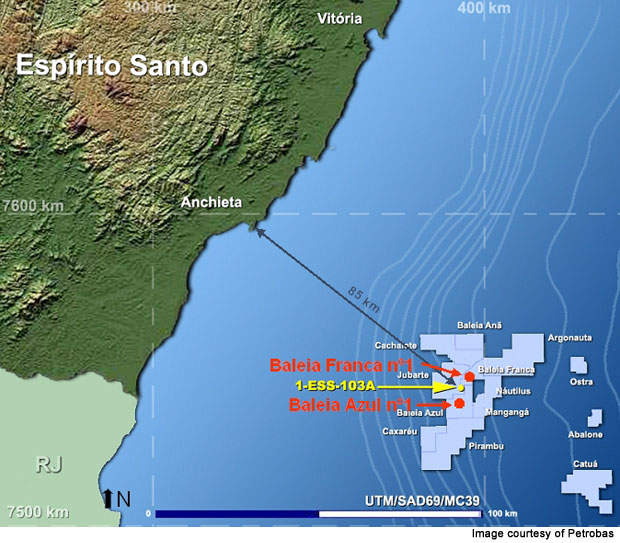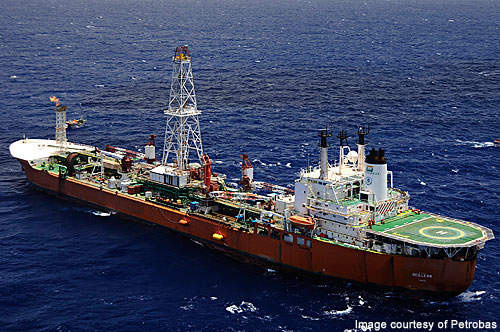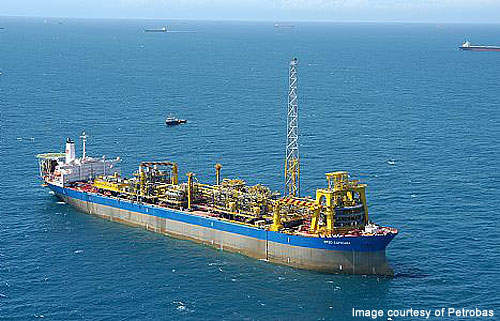The Cachalote oil field is located in the Campos Basin in south-eastern Brazil. It is operated by Petrobras.
Location
The Campos Basin is located beneath the coastal plain in the western portion of the South Atlantic Ocean and covers an area of 100,000km². It was discovered by drilling well ESS-116 in November 2002 at a depth of 1,478m. It contains 40 fields operated by Petrobras.
Geology
The basin has more than 30 hydrocarbon accumulations, which contribute to approximately 60% of Brazil’s oil production.
The accumulations are distributed across the stratigraphic column of the basin from Neocomian to Miocene. Reserves are accounted majorly from lacustrine calcareous black shales which are deposited in a closed Upper Neocomian lake system.
Development
The development of the field started with a pilot phase which involved the drilling of a production well that produced oil in 2008. Phase I involved the drilling of eight production wells and three injection wells. First oil from phase I was produced in May 2010.
Production
The field started producing in May 2010. The first production well, 7-CHT-5HA-ESS, was estimated to produce 22,000bpd. Field production doubled to 44,000bpd in June 2010.
Pilot phase production was carried out by using the floating production, storage and offloading vessel (FPSO) Seillean. The FPSO was deployed at the field in late 2008. Phase I production is being carried out using the FPSO Capixaba.
FPSO Capixaba
The Capixaba is owned by Amsterdam-based SBM Offshore. Petrobras leased the FPSO from SBM for 12 years from 2010. The vessel was secured as part of the integrated development of interconnecting Cachalote and Baleia Franca fields.
The FPSO operates at a depth of 1,480m and has a capacity to accommodate 96 personnel. It can process one million barrels of oil a day and has a gas production capacity of 3.2 million cubic metres a day. Its storage capacity is 1.6 million barrels a day.
The vessel will be connected to nine wells including three production and two injection wells at Cachalote, and three production wells and one injection well at Baleia Franca.
The FPSO was built by Singapore-based Keppel Shipyard/JC Marine in 2006. It was disconnected from the Golfinho field in August 2009 to relocate to the Cachalote Field.
SBM upgraded Capixaba to match the requirements of heavy oil of the Cachalote and Baleia Franca fields. The upgrade included the installation of crude oil inlet heaters, deck boilers and waste heat recovery units to the existing gas turbines. Piping, change of material in pipe rack and other precautions were carried out to avoid corrosion.
Additional gas compressors were added and the existing main gas compressors were upgraded.
The upgraded FPSO was installed at the field in March 2010.
FPSO Seillean
The FPSO Seillean was built in 1989 by Noble Corporation. It is 249.7m long, 37m wide and has a storage capacity of 310,000bbl and can process up to 20,000bpd.
The vessel has a displacement of 79,600t and can operate at a depth of 20.5m. It is powered by three gas turbines of 3.3MW each, and three generators each of 4.2MW.
Contractors
Petrobras awarded the lease contract of the Capixaba to SBM Offshore in the second quarter of 2008. VME Process supplied a glycol dehydration unit and separator packages for the Capixaba. In 2009, VME installed the Amine sweetening module prior to the FPSO’s relocation.









